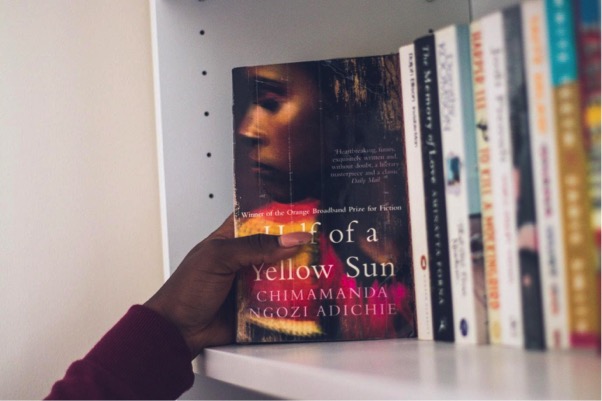What Makes a Good Book Cover?
There is an old saying that goes: “Don’t judge a book by its cover”. It is a meaningful message to bring into your everyday life; of not basing your judgements on appearances only. But in the case of books? It could not be more out of place.
 Photo credit: Justin Aikin on Unsplash
Photo credit: Justin Aikin on Unsplash
As Oscar Wilde said:
“It’s only shallow people who do not judge by appearances.” (1891; in Kratz, 1994)
Book covers are meant to be judged. And probably has been since the first “covers” originated in the medieval times. It is (to some extent) the whole idea of the cover. A cover is a marketing device; a representation of the book’s content, made in order to increase sales and ultimately appeal to an audience. Often it can make or break the success of a book.
Walking into a bookstore, there are often particular books that catches one’s eye amongst the dozens of other books on the shelves. If a certain cover has lured a potential customer in, and provided the minimum necessary information about the content, it is often enough to appeal the person into purchase. If the cover does not grab the person’s attention or interest, it is unlikely to be picked up in the first place.
But what exactly is it that makes a book cover good?
The basic anatomy
For starters, it has to have the essential elements that makes it a cover. These elements are either placed on the front cover or the back cover.
The front cover is usually the first thing part of the book that you see (although sometimes it can be the spine). It has the important job of attracting potential customers in. Typically, the elements here consist of a title, author(s) name, an illustration/image/graphics, and a subtitle or tagline (Lant, 2017).
The back cover is for the book description and other useful information. As Corinne Kratz notes, it is clearly ‘recognized as the realm of publishers, editors and marketing specialists’ (1994, p. 185). It usually includes the summary of the book, endorsement, a barcode, the price, and sometimes author information (Lant, 2017). The purpose of the back cover is to “finish” the job, to compel the potential customers into purchase.
The greater meaning
In order for book covers to be good, they have to be made with the audience’s point of view in mind. This means not only including the basic elements, but also adding greater meanings into these. These meanings are often constructed with allegory, category and lure in mind.
Often, what makes a cover good is that the featured illustrations, images or graphics encourage an allegorical narrative; which means that there is a second meaning which lies hidden behind the visible, literal one (Kratz, 1994, p. 181). This helps add different layers of significance to the cover, causing intrigue to what the book’s content is about. However, the meanings derived from allegories can sometimes be uncertain, as people’s interpretations are based on cultural, historical and political motivation (ibid, p. 194). Nevertheless, it can be an effective tool in sparking interest.
A good book cover should also tell the category and genre of the content. In the process of designing a cover to represent a certain genre, all elements come into play, with (typically) colour and imagery both playing key roles. To set an example, literary novels are often recognised by their soft colours; romance novels by the imagery of a couple locked in an embrace; and thrillers by the bold title and dark colours (Thacker, 2013). By emphasizing the category or genre of the book through the cover, the book is more likely to reach out and appeal to the right audience.
Last but not least, lure and identity play important roles in making a book cover good. A part from inspiring allegorical narratives and telling the category, covers should also strive to attract interest and communicate the identity of the book and content. As Marco Sonzogni says, the cover should emphasize ‘the special qualities and individual imaginative space of the book’ (2011, p. 16). Without it, you lose the essential essence.
In whatever form they appear one thing is certain. The covers of books matters. It is a vital part in both selling the books and telling the stories.
As Alexis Weedon says:
“Book covers can be seen as a doorway through which we glimpse the text. […] It is the threshold between the public commercial arena where the book is for sale and the more intimate world of the text where the author speaks to us alone. […] The cover dallies with us – should we open the book? Should we take it and own it? Will it give us the enjoyment we seek?” (2007; in Sonzogni, 2011, p. 10)
References:
Kratz, C. (1994) ‘On Telling/Selling a Book by Its Cover.’ Cultural Anthropology, 9(2).
Lant, K. (2017) ‘Anatomy Of A Book Cover’ [online] 99designs. Available at: <https://99designs.no/blog/book-design/anatomy-of-a-book-cover/> [Accessed 19 April 2020].
Sonzogni, M. (2011) Re-Covered Rose: A case study in book cover design as intersemiotic translation, John Benjamins Publishing Company, Amsterdam.
Thacker, N. (2013) ‘Why You Should Judge A Book By Its Cover’ [online] The Book Designer. Available at: <https://www.thebookdesigner.com/2013/01/nick-thacker/> [Accessed 19 April 2020].